Themed STEM Courses
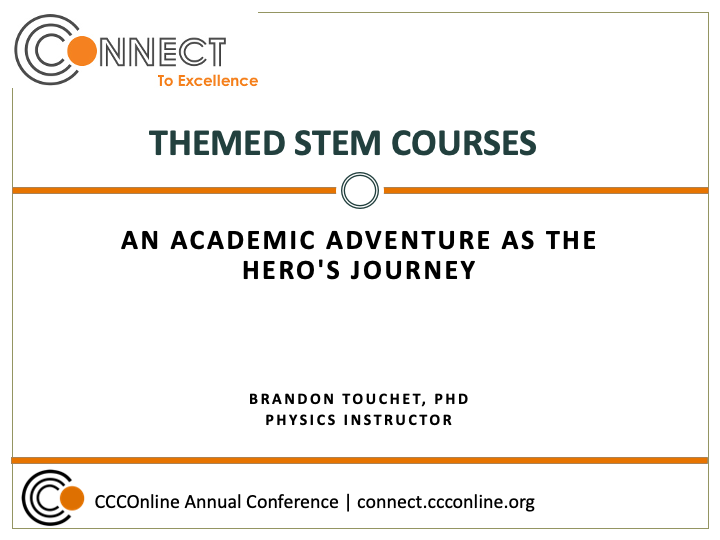
A new approach to teaching STEM.
This is a written version of my presentation “Themed STEM Courses” from the 2020 CCCOnline Connect Conference.
Introduction
Thanks for coming to my presentation. For those of you who don’t know me my name is Brandon Touchet. I’m from South Louisiana. I’ve taught physics at CCCOnline for 3.5 years.
We aren’t known for high education standards in the south but I owe all of my success to my education and those educators that helped me along the way. Because of their profound impact on my life I teach as a means of paying it forward. So when I hear my students say things such as * “I’m here because my major requires it.” * “I’m taking this course because I need another science elective to graduate and the other sciences were full.” * “My advisor said online was easier.”
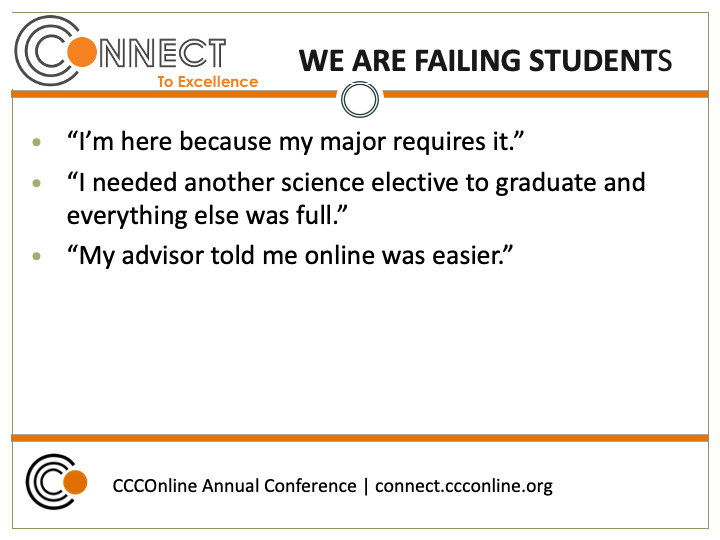 Quotes from my students on why they are taking physics.
Quotes from my students on why they are taking physics.
It feels like failure. And this presentation is my attempt at correcting this narrative.
Literature vs. STEM
Open a literature book and you’re met with beautiful poetry and elegant scripture. Open a physics book and you’re met with chaos.
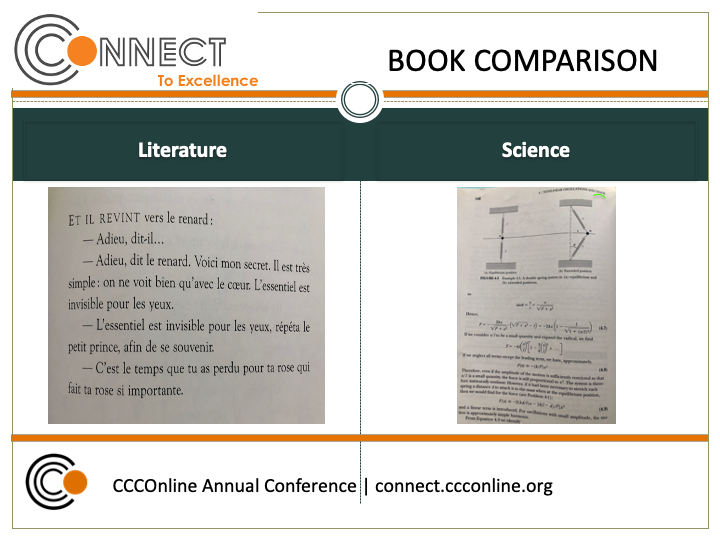 Literature vs Physics books.
Literature vs Physics books.
So it should be no surprise that Halliday & Resnik or Landau & Liftshitz aren’t at the top of the best sellers list.
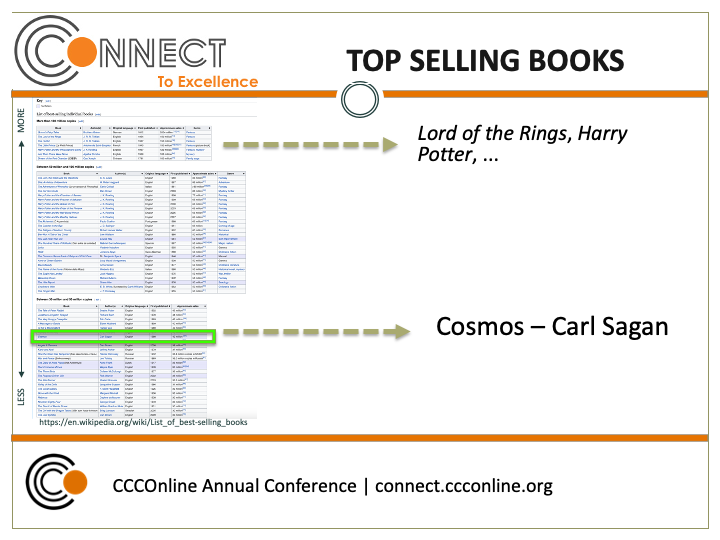 Wikipedia best selling books list.
Wikipedia best selling books list.
What is at the top are books like Harry Potter, Lord of the Rings, and The Little Prince. There is, at least, some hope towards the bottom of the list with Carl Sagan’s Cosmos, based off his successful tv-series. And: what’s common between these best sellers is narrative.
We don’t empathize with numbers, equations, and jargon. We empathize with narrative. We empathize with story. Look at this example from HBO’s series Chernobyl.
Scientist: The core is exposed.
Politician: I don't see how you can tell that from here.
Scientist: Oh. For god sakes. Look at that glow. That's radiation ionizing the air.
Politician: If we can't see we don't know. Get us directly over the building!
Scientist: Boris! If we fly directly over the reactor we will be dead within a week!
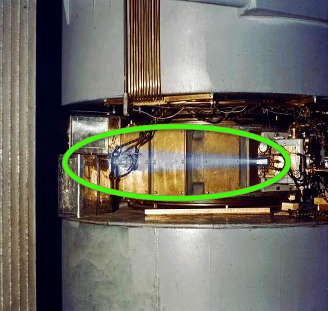 Chrenkov Radiation
Chrenkov Radiation
This scence uses narrative to communicate high-level physics, Chrenkov Radiation and radiation poisoning. Or this other scence from the show.
Worker: It's not 3 Roentgen. It's 15,000."
Politician: What does that number mean?
Scientist: It means the core is open. It means the fire we are watching with our own eyes is giving off nearly twice the radiation released by the bomb in Hiroshima. . . Every single hour. Hour after hour. Twenty hours since the explosion, so that's 40 bombs worth by now. Forty-eight more tomorrow. And it will not stop, not in a week; not in a month. It will burn and spread its poison until the entire continent is dead.
This scene uses narrative to communicate the magnitude of the disaster and the potential impact.
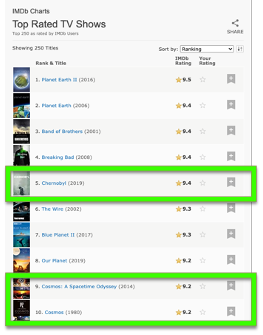 IMDB Top 10 TV Shows. Seven of the top ten are science based.
IMDB Top 10 TV Shows. Seven of the top ten are science based.
IMDB’s Top 10 TV Series shows that seven of the top ten are science based. So, it’s not that people hate science. They just hate how we teach it. Unforunately there is no way around mastering a second language–nature’s language, mathematics–if we want to study STEM. But: we can work to make STEM more appealing by using narrative.
The Hero’s Journey
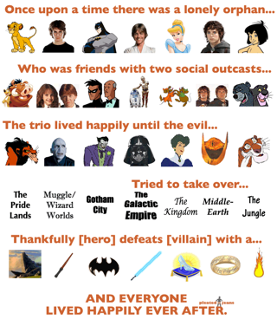 General script of the hero’s journey.
General script of the hero’s journey.
Behind all narrative is the hero’s journey, and it goes something like
Once upon a time there was a lonely orphan
Who was friends with two social outcasts
The trio lived happily
Until evil tried to take over
Thankfully the hero defeats the villian with an exclir
And everyone lived happily ever after
This same motif is played out in Lion Kind, Harry Potter, Batman, Star Wars, Cinderella, Lord of the Rings, and the Jungle Book. It even plays out in Chernobyl. Just look at Google’s summary of the show.
Brave men and women act **heroically* to mitigate catastrophic damage when the Chernobyl Nuclear Power Plant suffers a nuclear accident on April 26, 1986.
Therefore, if we want to make STEM more engaging for the STEM major, more accessible for the non-major, and more entertaining for all we should borrow the success of those before and use narrative!
Just look at the opening lecture from the most successful set of physics books ever written, The Feynman Lectures.
If, in some cataclysm, all of scientific knowledge were to be destroyed, and only one sentence passed on to the next generations of creatures, what statement would contain the most information in the fewest words?
Feynman uses this question to allow the audience a chance at developing their own statement. But they audience would likely not have the insight of Feynman, a Nobel Laurate physicist, so he bequeths them an answer. His cataclysm sentence is the atomic hypothesis:
. . .all things are made of atoms—little particles that move around in perpetual motion, attracting each other when they are a little distance apart, but repelling upon being squeezed into one another…
From this simple statement Feynman goes on to derive all of introductory physics in three volumes, one volume per semester, 115 chapters, and each chapter its own lecture as its own miniature adventure. We can do the same with our STEM courses but we can also do more. We can make STEM modern and relevant.
When Feynman published these lectures in 1963 humanity hadn’t even landed on the Moon yet. Now, in 2020, NASA would like to use the Moon as an intermediate base for travel to Mars. Thus, if we want to make STEM more appealing and relevant we can use the notion of Themed STEM Courses.
Themed STEM Courses
Recall the basic structure of the hero’s journey. The hero joins a group. The group faces adversity. The group overcomes said adversity. So, we structure the courses similarly.
We divide the roster into groups. Next we give them a relevant, modern problem. For this example I have choosen NASA’s BIG Idea Challenge for 2021. Finally, we build the course in such as was as to help them win. A win in this case does not mean they provide the winning solution for NASA. Rather, a win is the group creating their own unique solution to the problem.
"Through its annual Breakthrough, Innovative and Game-changing (BIG) Idea Challenge, NASA is looking for a wide range of creative solutions from college and university students on the **theme of lunar dust mitigation**. Categories under the theme include dust prevention and mitigation during landings, spacesuit dust tolerance, exterior dust clean up, and controlling lunar dust within habitats. Competition judges will select between five and 10 teams to receive up to $180,000 each to build, test, and demonstrate robust lunar dust mitigation, or dust tolerant capabilities and technologies."
— NASA BIG Idea Challenge for 2021
NASA’s BIG Idea Challenge for 2021 is on the theme of lunar dust mitigation with four categories: (1) one, (2) two, (3) three, (4) four. A typical online physics course for me has between 20 and 30 students. That is five to six students per group. Each group works on one of the problems. Thus, our task as educators is to build a course around this structure.
We typically have chapter lectures, each lecture focused on a topic (e.g. gravity, Ohm’s Law, fields and waves) but uniquely focused for our theme. So we have find a novel structure for “chapters”. For our online courses we also have weekly discussions, which we now center on dust mitigation. We can also choose to leave the homeworks and exams as they are classically because they evaluate the most fundamental concepts. We can, however, replace the typical lab experiments with either dust related experiments or milestones. Finally, we replace the final with a written proposal for the group’s solution to their dust problem and the milestones are used to help write this proposal.
Keep in mind that the course need not follow the BIG Idea challenge, only a theme. So, continuing with space, we could follow the theme of Space Travel-Mars. We could create miniature themes. Let’s call them modules. For example, the first module is getting off Earth, Lift. Another theme could be Landing. A third possible module is Energy or Payload, where we focus on the restrictions of travel such as needing to conserve weight and space on the spaceship. A fourth could be Habitat, working out living conditions.
A semester is 15 weeks, which is about four months. That is four modules. Each module ending with a project which addresses the module’s theme. The final would follow as a formal proposal with all components, a budget, and science to support.
Conclusion
To make STEM more appealing and relevant I propose we use the notion of a themed course. A themed course is meant to divide the students into groups with each group working together on a relevant problem for today’s scientific advancements. This new structure should challenge the student’s creativity, interpersonal skills, scientific understanding, and excite them about the possibilities of tomorrow.